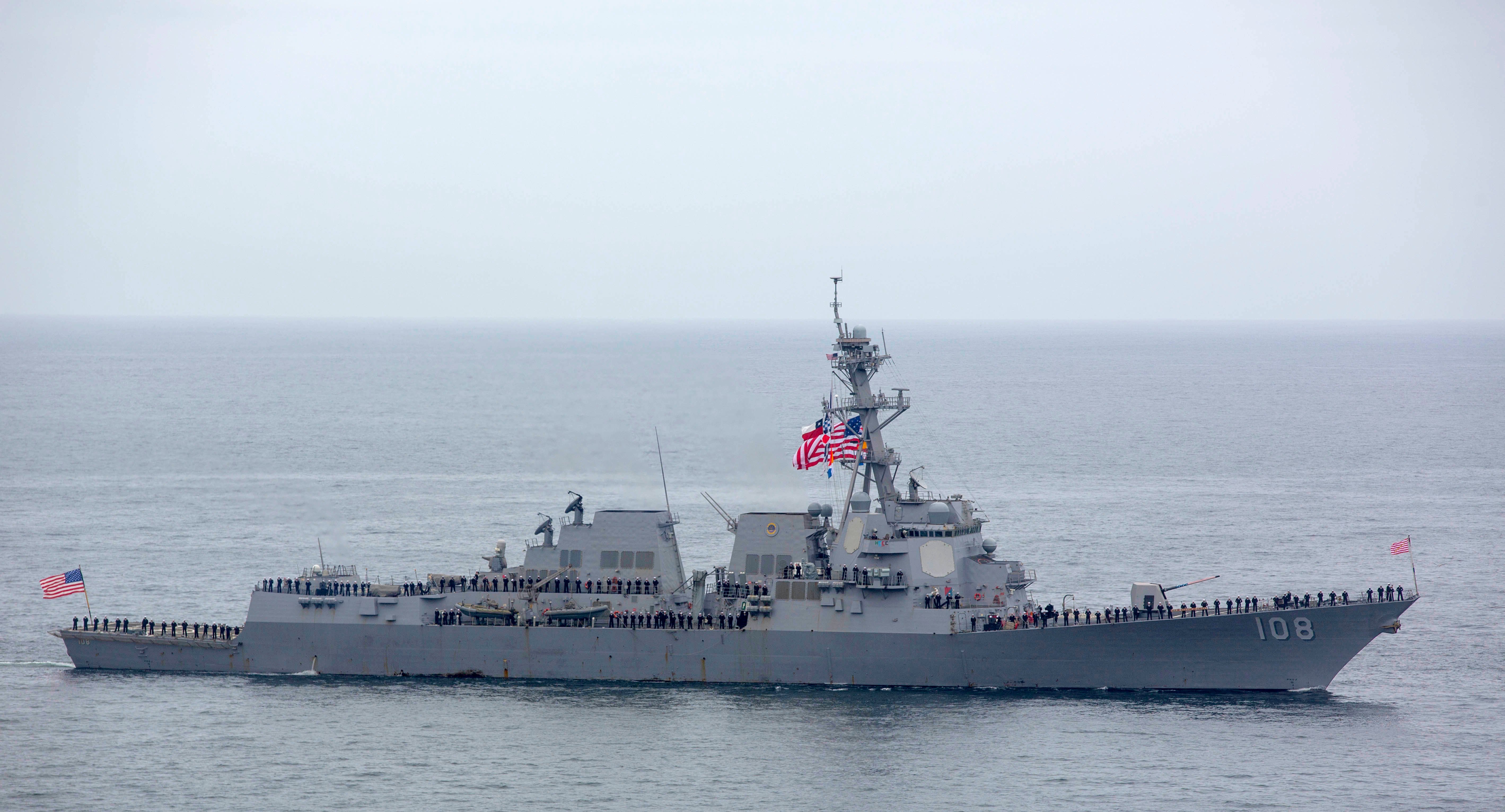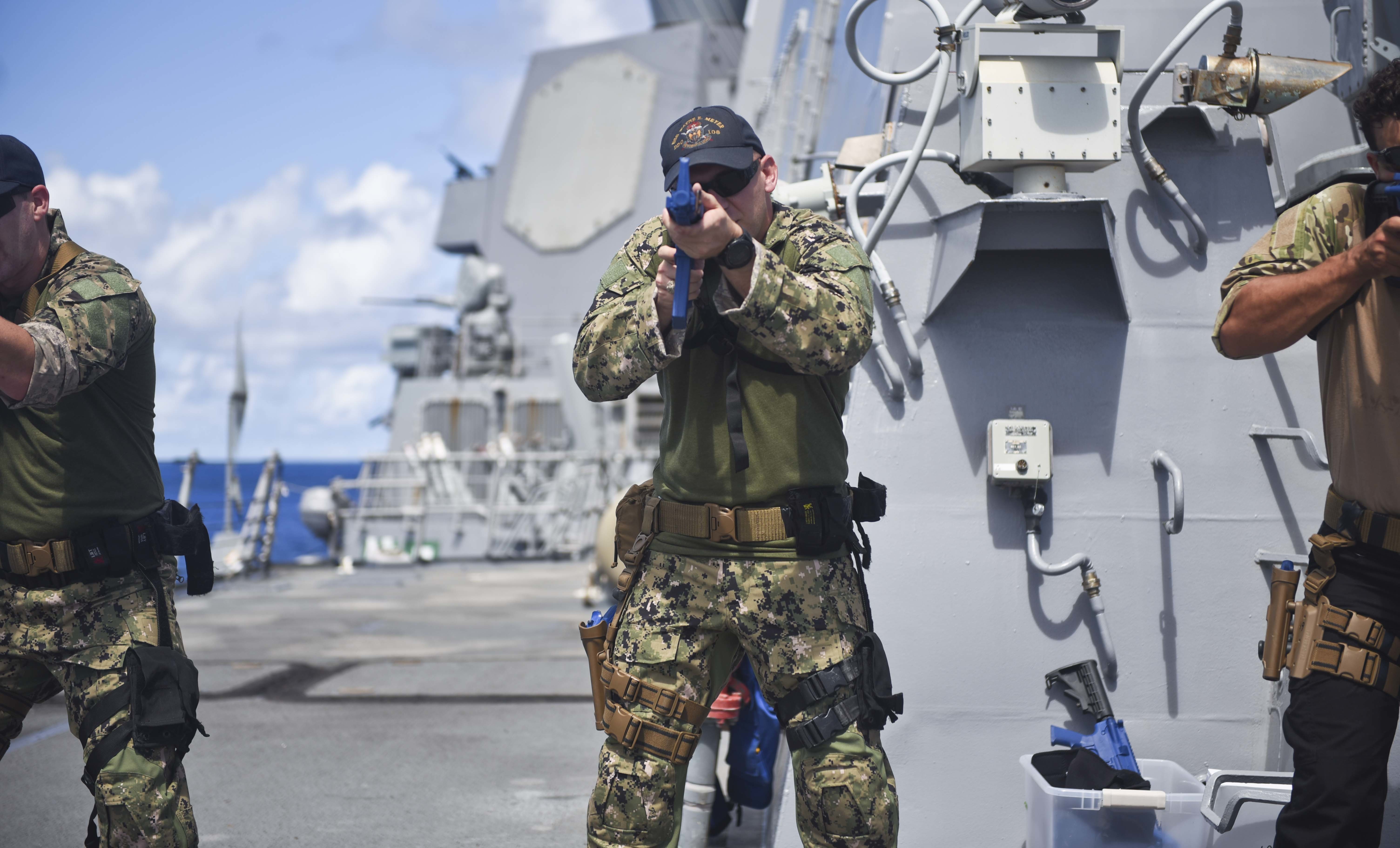By Megan Eckstein

Sailors man the rails aboard the Arleigh Burke-class guided missile destroyer USS Wayne E. Meyer (DDG 108) as the ship transits along the coast of Valparaiso, Chile during a parade of ships on Nov. 19, 2018.
A U.S. destroyer conducted a freedom of navigation operation in the Spratly Islands today.
Arleigh Burke-class destroyer USS Wayne E. Meyer (DDG-108) sailed within 12 nautical miles of both Fiery Cross Reef and Mischief Reef today to challenge excessive maritime claims in the South China Sea, U.S. 7th Fleet spokeswoman Cmdr. Reann Mommsen told USNI News.
“U.S. Forces operate in the Indo-Pacific region on a daily basis, including in the South China Sea. All operations are designed in accordance with international law and demonstrate that the United States will fly, sail and operate wherever international law allows,” she said.
Ships operating the U.S. Indo-Pacific Command have conducted several FONOPS this year, with officials saying they wanted FONOPS to be viewed as more routine operations.
In late May, USS Preble (DDG-88) sailed near the Scarborough Shoal, and earlier that month Preble and USS Chung-Hoon (DDG-93) steamed within 12 nautical miles of the Gaven and Johnson Reefs.
In February, Preble and USS Spruance (DDG-111) steamed within 12 nautical miles of Mischief Reef, an artificial island China built up in the Spratly Islands chain.
In February, Preble and USS Spruance (DDG-111) steamed within 12 nautical miles of Mischief Reef, an artificial island China built up in the Spratly Islands chain.
In January, USS McCampbell (DDG-85) steamed past the Paracel Islands.

Ens. Christian Meyer practices visit, board, search and seizure (VBSS) techniques aboard the Arleigh Burke-class guided-missile destroyer USS Wayne E. Meyer (DDG 108) on Aug. 22, 2019. Wayne E. Meyer is deployed to the U.S. 7th Fleet area of operations in support of security and stability in the Indo-Pacific region.
The South China Sea continues to be a key location where U.S. warships promote freedom of navigation and open international waterways, and also where China has taken a stand this summer.

Ens. Christian Meyer practices visit, board, search and seizure (VBSS) techniques aboard the Arleigh Burke-class guided-missile destroyer USS Wayne E. Meyer (DDG 108) on Aug. 22, 2019. Wayne E. Meyer is deployed to the U.S. 7th Fleet area of operations in support of security and stability in the Indo-Pacific region.
The South China Sea continues to be a key location where U.S. warships promote freedom of navigation and open international waterways, and also where China has taken a stand this summer.
A group of Chinese warships, including aircraft carrier Liaoning, sailed through the South China Sea earlier this summer, operating in territorial waters of the Philippines and near Japan.
When Wayne E. Meyer conducted its FONOP today, other ships were in the vicinity, but all interactions were considered routine, a source told USNI News.
Today’s operation comes just after China denied a U.S. Navy request to send a warship to the eastern port city of Qingdao, Reuters first reported.
When Wayne E. Meyer conducted its FONOP today, other ships were in the vicinity, but all interactions were considered routine, a source told USNI News.
Today’s operation comes just after China denied a U.S. Navy request to send a warship to the eastern port city of Qingdao, Reuters first reported.
The U.S. and China are locked in a growing trade war, and while U.S. Navy ships have made port visits in Chinese cities previously, the rejection of the request may reflect those growing tensions between the two economic powers.
China also denied two warships access to Hong Kong, the semi-autonomous islands where protests against the government in Beijing are ongoing.
The full statement from U.S. 7th Fleet:
“The guided-missile destroyer USS Wayne E. Meyer (DDG 108) conducted a Freedom of Navigation Operation (FONOP) in the South China Sea, Aug. 28 (local time). Wayne E. Meyer sailed within 12 nautical miles of Fiery Cross and Mischief Reefs in order to challenge excessive maritime claims and preserve access to the waterways as governed by international law. U.S. Forces operate in the Indo-Pacific region on a daily basis, including in the South China Sea. All operations are designed in accordance with international law and demonstrate that the United States will fly, sail and operate wherever international law allows. That is true in the South China Sea as in other places around the globe. We conduct routine and regular Freedom of Navigation Operations (FONOPS) as we have done in the past and will continue to in the future. FONOPs are not about any one country, nor are they about making political statements.”
The full statement from U.S. 7th Fleet:
“The guided-missile destroyer USS Wayne E. Meyer (DDG 108) conducted a Freedom of Navigation Operation (FONOP) in the South China Sea, Aug. 28 (local time). Wayne E. Meyer sailed within 12 nautical miles of Fiery Cross and Mischief Reefs in order to challenge excessive maritime claims and preserve access to the waterways as governed by international law. U.S. Forces operate in the Indo-Pacific region on a daily basis, including in the South China Sea. All operations are designed in accordance with international law and demonstrate that the United States will fly, sail and operate wherever international law allows. That is true in the South China Sea as in other places around the globe. We conduct routine and regular Freedom of Navigation Operations (FONOPS) as we have done in the past and will continue to in the future. FONOPs are not about any one country, nor are they about making political statements.”
Aucun commentaire:
Enregistrer un commentaire